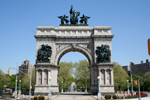Grand Army Plaza
Grand Army Plaza is also the name of a plaza at the intersection of 59th Street and 5th Avenue in front of the Plaza Hotel in Manhattan, and opposite the southeastermost corner of Central Park. It is the site of a fountain contributed by Joseph Pulitzer.
Grand Army Plaza in Brooklyn, New York is an 11-acre oval plaza that forms the main entrance to Prospect Park. It was designed by Frederick Law Olmsted and Calvert Vaux in 1867. It consists of concentric rings arranged as streets, with the outer ring being named Plaza Street. The inner ring was originally intended to be a circle, but it actually was arranged as a main street – Flatbush Avenue – with eight radial roads connecting: Vanderbilt Avenue; Butler Place; Saint John’s Place (twice); Lincoln Place; Eastern Parkway; Prospect Park West; Union Street; and Berkeley Place. As completed, the only streets that penetrate to the inner ring are Flatbush Avenue, Vanderbilt Avenue, Prospect Park West, Eastern Parkway, and Union Street.
Originally known as Prospect Park Plaza, but renamed in 1926, it is perhaps best known for the Soldiers’ and Sailors’ Memorial Arch, Brooklyn’s version of the Arc de Triomphe. It is also the site of the Bailey Fountain and a monument to John F. Kennedy, as well as statues of Civil War generals Gouverneur Kemble Warren and Henry Warner Slocum, along with busts of notable Brooklyn citizens Alexander J.C. Skene and Henry W. Maxwell.
Prospect Park Plaza (as it was originally known) was conceived by its designers, Frederick Law Olmsted and Calvert Vaux, simply as a grand entrance to the Park. It was meant as a gateway, to separate the noisy city from the calm nature of the Park. Olmsted and Vaux’s design included only a single-spout fountain surrounded by berms (earth embankments) covered in heavy plantings. They still shield the local apartment buildings and the main branch of the Brooklyn Public Library from the noisy traffic circle that has developed.
On August 6, 1889, a blind jury of two experts, appointed by the Soldiers and Sailors Monument Commission, selected the design of John H. Duncan from a field of thirty six entries that had been submitted the previous year. Duncan, who designed Grants Tomb in the following decade, proposed a free-standing memorial arch of a classical style similar to the Arc de Triomphe in Paris. After two and a half months of site preparation, William Tecumseh Sherman laid the cornerstone of the arch on October 10, 1889. After almost three years of construction, President Grover Cleveland presided over the unveiling on October 21, 1892.
Inside the arch and on facing walls are equestrian relief sculptures of Abraham Lincoln and Ulysses S. Grant. William Rudolf O’Donovan (1844-1920) sculpted both men and Thomas Eakins (1844-1916) did the two horses.
The Arch gained its monumental statues nine years later. They were first suggested by the architectural firm of McKim, Mead and White as part of a plan to formalize the plaza in the spirit of the City Beautiful movement. Park Commissioner Frank Squire liked the proposal and in 1894 engaged Frederick MacMonnies to design three sculptural groupings for the Arch, the Quadriga, The Spirit of the Army, and The Spirit of the Navy.
The Quadriga resides at the top and depicts the lady Columbia, an allegorical representation of the United States, riding in a chariot drawn by two horses. Two winged Victory figures, each leading a horse, trumpet Columbia’s arrival. The lower pedestals facing the park hold the Spirit of the Army group and the Spirit of the Navy group. Installation of the groups began four years later, starting with the Quadriga on December 4, 1898, and finishing with the Navy group on April 13, 1901. The work took nearly seven years to complete, about twice as long as the construction of the arch itself. The arch is 80 feet high and 80 feet wide with an interior arch height of 50 feet.
